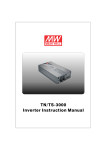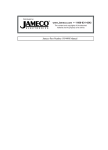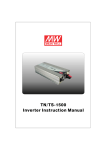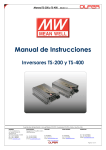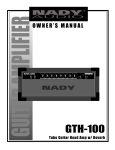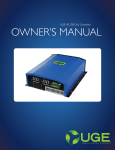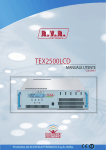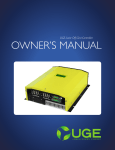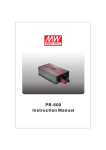Download Mean Well TS-200 Instruction manual
Transcript
TS-200/400 Inverter Instruction Manual TS-200/400 Inverter Instruction Manual Index 1. Safety Guidelines ............................................................................... 1 2. Introduction ........................................................................................ 1 2.1 Features ......................................................................................... 1 2.2 Main Specification ........................................................................ 2 3. User Interface ...................................................................................... 3 3.1 Front Panel .................................................................................... 3 3.2 LED Indicator on Front Panel ...................................................... 3.3 Rear Panel .................................................................................... 4. TS-200/400 setup (Output Voltage & Frequency) ............................. 4.1 Initial State .................................................................................. 4.2 Procedure of Setting Up Output Voltage and Frequency............ 3 3 4 4 4 5. Protection ........................................................................................... 5 5.1 Input Protection ........................................................................... 5 5.2 Output Protection ........................................................................ 6 6. Installation & Wiring .......................................................................... 6 7. Failure Correction Notes ................................................................... 9 8. Warranty ............................................................................................. 9 Jul. 2010 Version 3 1.Safety Guidelines (Please read through this manual before assembling TS200/400) Risk of electrical shock and energy hazard. All failures should be examined by a qualified technician. Please do not remove the case of the inverter by yourself! Please do not install the inverter in places with high moisture or near water. Please do not install the inverter in places with high ambient temperature, under direct sunlight or near flame source. Please only connect batteries with the same brand and model number in one battery bank. Using batteries from different manufacturers or different capacity is strictly prohibited! Never allow a spark or flame in the vicinity of the batteries because it may generate explosive gases during operation. Make sure the air flow from the fan of TS-400 is not obstructed at both sides (front and back) of the inverter. Please allow at least 15cm of space. Please do not stack any object on the inverter because it may impede heat dissipation. WARNING: Batteries will have aging problem after years of operation. It is suggested to execute regular battery maintenance (e.g. every year). Once aged, the batteries should be changed by professional technician, or the failed batteries may cause fire or other hazards. Inverter Inverter Don't disassemble Keep away from moisture Inverter Keep away from fire or high temperature Don't stack on the inverter Inverter Keep good ventilation 2.Introduction TS-200/400 is a DC/AC True Sine Wave Inverter using the latest high frequency High performance inverter designed for use with battery bank drawing power from the battery and converting it into AC voltage. TS-200/400 can continuously provide 200W/400W of pure sine wave output with THD < 3% to various types of loads (e.g. inductive & capacitive). It can also provide short term power of 230W/460W for 3 minutes and 300W/600W for 10 seconds. It can withstand surge requirement of 400W/800W for 30 AC cycles. Reduction in product size and high efficiency of 88.5% were achieved through the use of high frequency switching technology. General applications include PC, ITE, vehicles, yachts, home appliances, motors, power . TS-200 does not have built-in fan and can be cooled with free air convection. 2.1 Features True sine wave output (THD < 3.0%) Rated power 200W (TS-200) / 400W (TS-400) High efficiency up to 88.5% 1 Remote ON/OFF control Complete protective features Output voltage / Frequency selectable Fully digital controlled Compliance to UL458 / FCC / E 13 / CE Can be used for most electronic products with AC input 3 years global warranty 2.2 Main Specification TS-200 Model Rated O power U T AC voltage P U T Waveform Protection Bat. voltage range I N DC current P Efficiency U Off mode T current draw Protection 124 148 212 224 248 112 200W continuously, 230W for 3 minutes, 300W for 10 seconds, and 400W for 30 AC cycles 110Vac, 60Hz (Factory setting) 230Vac, 50Hz (Factory setting) 100/110/115/120Vac (Selectable by setting button) 200/220/230/240Vac (Selectable by setting button) 50/60Hz (Selectable by setting button) True sine wave (THD <3.0%) at rated input voltage AC short, overload, over temperature 10.5 ~ 15.0V 21.0 ~ 30.0V 42.0 ~ 60.0V 10.5 ~ 15.0V 21.0 ~ 30.0V 42.0 ~ 60.0V 20A 86% 10A 87.5% 5A 88% 20A 86% 10A 87.5% 5A 88% Under 1.0mA when power switch is in the OFF position Over current, battery reverse polarity by fuse, battery low shutdown, Battery low alarm TS-400 Model Rated O power U T AC voltage P U T Waveform Protection 124 148 212 224 248 112 400W continuously, 460W for 3 minutes, 600W for 10 seconds, and 800W for 30 AC cycles 110Vac, 60Hz (Factory setting) 230Vac, 50Hz (Factory setting) 100/110/115/120Vac (Selectable by setting button) 200/220/230/240Vac (Selectable by setting button) 50/60Hz (Selectable by setting button) True sine wave (THD <3.0%) at rated input voltage AC short, overload, over temperature Bat. voltage 10.5 ~ 15.0V 21.0 ~ 30.0V 42.0 ~ 60.0V 10.5 ~ 15.0V 21.0 ~ 30.0V 42.0 ~ 60.0V range I 20A 10A 40A 20A N DC current 40A P Efficiency 84.5% 86% 87% 86% 87.5% U Off mode T Under 1.0mA when power switch is in the OFF position current draw Protection 10A 88.5% Over current, battery reverse polarity by fuse, battery low shutdown, Battery low alarm 2 3. User Interface 3.1 Front Panel A AC output outlet: For application demands of different geographic areas all over the world, there are many different kinds of optional AC outlets to choose from. Receptacle types Area Type-A Type-B Type-C Type-D Type-E Type-F USA Europe Australia U.K. Japan GFCI B LED Indicating Panel: Shows inverter operating status. C Function Setting: Output voltage and frequency can be set through this button. D Ventilation holes: Please make sure there is good ventilation and the lifespan of the inverter can be preserved. D A B AC OUTPUT Status Setting C Figure 3.1: Front Panel 3.2 LED indicator on front panel Status LED: Represents TS-200/400 current operating status Green Orange (flashing) Red LED color Status Normal Remote control OFF Abnormal *Note: Refer to section 5.2 for explanation of abnormal status 3.3 Rear panel A Battery input (+),(-) B Ventilation opening C Power ON/OFF switch D Remote control connector (JST B-XH) E Frame ground (FG) 3 C C B Reverse Polarity Will Damage The Unit. ON _ _ D _ _ OFF Chassis Ground R.C E Reverse Polarity Will Damage The Unit. ON _ _ OFF B Chassis Ground R.C (TS-200) A E D (TS-400) A Figure 3.2: Rear Panel 4. TS-200/400 setup (Output Voltage & Frequency) 4.1 Initial State The initial states of the inverters are either 110Vac/60Hz or 230Vac/50Hz. If users need to revise it for certain application, it can be done using the setting button on the front panel (Please refer to section 4.2). The unit will start up automatically after the setting procedure is finished and the new settings will be executed. These new settings will be kept even if the unit is power off/on for any reason. 4.2 Procedure of Setting up Output Voltage and Frequency STEP 1: The inverter should be turned off before resetting. Input batteries should be connected and the loads should be removed. STEP 2: Use an insulated stick to press the setting button and then turn on the power switch. Orange led indication will flash ON and OFF. After pressing for 5 seconds, the inverter will send out a "Beep" sound. Users can release the button and go on with the setting procedure. STEP 3: Please refer to Table 4-1 and check whether the output voltage is what you need. If yes, please skip to STEP 5. If not, start from STEP 4. AC OUTPUT Status Setting Use an insulated stick to press this setting button Figure 4.1 Adjustment of output voltage and frequency Table 4-1 LED indication of output voltage Output voltage LED Continuous 100V/(200V) (Red) 110V/(220V) (Red) Flashing 4 115V/(230V) (Green) 120V/(240V) (Green) STEP 4: The LED will change state each time you press the setting button for 1 second and then release (refer to Figure 4.2). Please select the voltage that you need. 110Vac (220Vac) 115Vac (230Vac) 100Vac (200Vac) 120Vac (240Vac) Figure 4.2: State Circulation Diagram of Output Voltage STEP 5: After selecting the output voltage, press the setting button for 3~5 seconds and the inverter will send out a "Beep" sound. Voltage setting is now finalized and you may go on to the frequency setting. STEP 6: Please refer to Table 4-2 and check whether the output frequency is what you need. If yes, please skip to STEP 8. If not, start from STEP 7. Table 4-2 LED indication of frequency selection Frequency LED 50Hz (Orange) 60Hz (Orange) Continuous Flashing STEP 7: The LED will change state each time you press the setting button for 1 second and then release (refer to Figure 4.2). Please select the frequency that you need. STEP 8: After setting the frequency, press the setting button for around 5 seconds and the inverter will send out a "Beep" sound. The button can be released and all the settings are finalized. The inverter will and all the settings are finalized. The inverter will automatically store all the settings and start to operate. 5. Protection 5.1 Input protection (A) Battery polarity protection: If the battery input is connected in reverse polarity, the internal fuse of the inverter would blow and the inverter should be send back to MEAN WELL for repair. (B) Battery low shutdown: When the battery voltage is lower then the preset value, the inverter will automatically terminate the output thus protect the battery from damage. (C) Battery OVP: When the battery voltage is too high, the inverter will automatically terminate the output and the built-in buzzer will be activated to inform the user. After bypassing the OVP condition, the inverter should be repowered ON to resume operation. 5 WARNING: Please choose suitable batteries that are compatible with the rated input DC voltage of TS-200/400 (refer to spec). If the input DC voltage is too low (ex. using 12Vdc battery bank for 24Vdc input models), TS-200/400 will not started up. If the input DC voltage is too high (ex. using 48Vdc battery bank for 24Vdc input models), TS-200/400 could get damaged! 5.2 Output protection The display panel will show failure status using red LED indicators when inverter is faced with abnormal operating conditions. This lets the user know there could be problems with their setup. (1) OTP: When the internal temperature is higher than the limit value, OTP will activate and automatically shutdown the unit. Users should wait for at least 30 minutes before restarting the unit. (2) AC output abnormal protection: When the AC output voltage of the inverter is too low or too high, the unit will turn OFF and should be restarted again. (3) AC output short circuit protection: When a short circuit situation occurs at the output side of the inverter or the load increase greatly in a short period of time, the unit will turn OFF and should be restarted again. (4) Battery voltage abnormal protection: When the battery voltage is too high or too low, this protection will be activated. Inverter will auto recover after the battery voltage goes back to a safe level and the user do not need to restart it. (5) OLP: When the output is overloaded between 210~230W (TS-200) / 420~460W (TS-400), the inverter can still continuously provide power for 3 minutes. After that, if the overload condition is not removed, overload protection will activate. When the load is higher than 400W (TS-200) / 800W (TS-400), the overload protection will be activated instantly. For these overload protections, once activated, the unit must reset to recover. 6. Installation & Wiring (A)Wiring for Batteries: Wire connections should be as short as possible and less than 1.5 meter is highly recommended. Make sure that suitable wires are chosen based on the current rating. Too small of a cross-section will result in overheating and could induce fire hazard. Table 6-1 Suggestion for wire selection Rated Current of Equipment (Amp) Cross-section of Lead (mm 2) AWG 10A ~ 13A 1.25 16 Inverter model TS-200 TS-400 148/248 13A ~ 16A 1.5 14 124/224 16A ~ 25A 2.5 12 25A ~ 32A 4 10 32A ~ 40A 6 8 40A ~ 63A 10 6 6 148/248 112/212 124/224 112/212 (B) Suggested battery type and capacity Battery type Battery capacity Lead-acid battery 112 212 124 12V / 120Ah ~ 12V / 400Ah 224 24V / 60Ah ~ 24V / 200Ah 148 248 48V / 30Ah ~ 48V / 100Ah (C) Requirements for Installation TS-400 should be mounted on a flat surface or holding rack with suitable strength. In order to ensure the lifespan of the unit, please refrain from operating in environment of high dust or moisture. Please make sure that ventilation is not blocked and avoid long term operation within high ambient environment or continuous overloading. There should be no barriers within 15cm of the ventilating holes. >15cm Air >15cm Inverter Air Figure 6.1: Example of Installation (D)Mounting Suggestion There are 4 semi-circular cut out on the side flanges of the inverter. It can be used for fixing TS-200/400 onto the system enclosure. We highly recommend mounting in the horizontal position. Please make sure ventilation openings are free from obstruction. 7 (E) Example of system diagram As short as possible Larger than 15cm AC O/P LOAD TS-200/400 Larger than 15cm Battery DC I/P -+ - + Chassis Should less than 1.5m Wall or system FG (F) Derating 100 100 Others 80 LOAD (%) LOAD (%) 80 60 TS-200-1xx 50 40 20 -10 60 40 20 0 10 20 30 35 40 Ambient Temperature ( 50 60 10.5VDC 21VDC 42VDC ) 11.5VDC 23VDC 46VDC 15VDC (HORIZONTAL) 30VDC 60VDC Battery Input Voltage (V) Figure 6.2: Output Derating Curve Figure 6.3: Input Derating Curve (G) Important notice on output load: TS-200/400 Series can power most equipment that needs an AC source. It can provide 200W (TS-200)/400W (TS-400) continuously. But for certain types of load, the unit may not work properly. (1) Since inductive loads or motor based equipments need a large start up current (6~10 times the rated current), the inverter may not start up successfully with these kind of load. The user must make sure the peak load specification of the inverter is suitable for their application. (2) When the output are capacitive or rectified equipment (such as switching power supply), it is suggested to operate these equipment at no load or light load during start up. To ensure smooth power ON, you should increase the load only after TS-200/TS-400 has started up. 8 7. Failure Correction Notes TS-200/400 should be serviced by a professional technician. Any improper usage or modification may damage the unit or result in shock hazard. If you are not able to clear the failure condition, please contact. Status Possible Reasons Ways to Eliminate Abnormal input Check the DC input source. Make sure the voltage is within the required range. Over temperature protection Make sure that the ventilation is not blocked or the ambient temperature is too high. Please derate the output usage or reduce the ambient temperature. Overload protection Make sure the output load does not exceed the rated value or the instantaneous start up current is not too high (for inductive or capacitive loads). Short circuit protection Make sure the output is not overloaded or short circuited. Discharging period of batteries is too short Batteries are aged or broken Replace the batteries. Fan does not spin (TS-400) Clog with foreign objects No AC output voltage Battery capacity is too small Reconfirm the specification and enlarge the battery capacity as suggested. Remove the foreign objects. Repair required. Please send it back to us or any of our distributors. Malfunction of the fan 8. Warranty Three years of global warranty is provided under normal operating conditions. Please do not change components or modify the unit by yourself or MEAN WELL may reserve the right not to provide the complete warranty. 9












